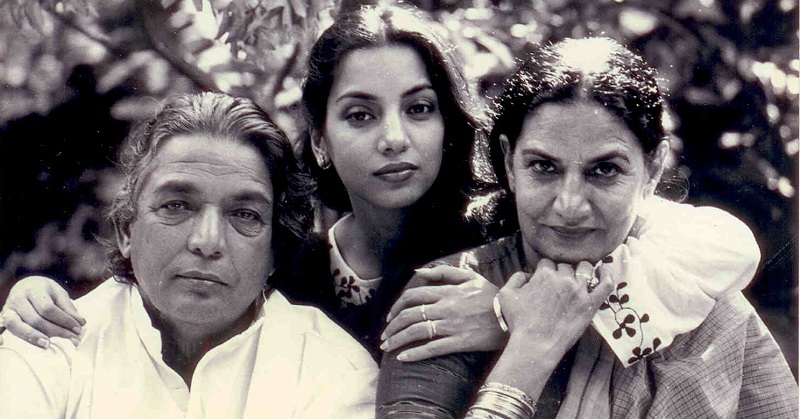Kaifi Azmi was a renowned Hindi and Urdu writer and lyricist of Hindi film. Azmi deserted his investigations of Persian and Urdu during the Quit India movement in 1942 and turned into a full-time Marxist. During this period, Azmi began to win incredible praise as an artist and turned into an individual from the Progressive Writers’ Movement of India.
Below are some facts about Kaifi Azmi, the man who is remembered as the one who brought Urdu literature to Indian motion pictures:
ADVERTISEMENT
1. Kaifi Azmi was born as Syed Athar Hussain Rizvi.
2. Kaifi was born on January 14 January 1919 into a Zamindar family in the village of Mizwaan in Azamgarh district of Uttar Pradesh.
3. Azmi composed his first ghazal when he was just 11 years old.
He wrote Itna To Zindagi Mein Kisi Ki Khalal Pade and managed to get himself invited to a mushaira. It was later immortalized by Begum Akhtar.
4. Kaifi joined the Communist Party at the age of 19
Then he started writing for the party’s paper, “Qaumi Jung” and moved to Bombay. He got enlivened by Gandhiji’s Quit India Movement in 1942. His first assortment of sonnets, Jhankar turned out in 1943. He additionally acquired the participation of the Progressive Writers’ Association in 1943.
Advertisment
Poet Kaifi Azmi with his comrades headed for a conference of Progressive Writers’ Association. thewire
ADVERTISEMENT
5. Azmi was married to an Indian theatre and film actress Shaukat Kaifi.
6. His kids are the renowned entertainer Shabana Azmi and the cinematographer Baba Azmi.
7. Kaifi composed tracks for multiple movies
Kaifi Azmi wrote his first film lyric Rote Rote Guzar Gayi Raat for Shahid Lateef’s Buzdil in 1951. Aside from composing tracks for movies like, Haqeeqat, Pakeezah, Arth etc. that went onto turning out to be works of art, Azmi likewise expounded generally on the issues confronting our ranchers and on the shared agreement.
ADVERTISEMENT
8. Kaifi only used blue black ink and always used fountain pens.
He always wrote on a particular lining pad. One of his most loved possesion was his collection of 18 Mont Blanc pens, which he would send all the way to the Fountain Pen Hospital in New York to be serviced.
Kaifi’s best known poems are Aurat, Makaan, Daaera, Sanp and Bahuroopni.
ADVERTISEMENT
9. Earned a very modest amount of money.
Kaifi was embarrassed to ask for raise in his price and many producer owed him money as he never asked for more.
10. He set up the Kaifi Azmi Higher Secondary School for Girls
The Kaifi Azmi Inter-College for Girls, Kaifi Azmi Computer Training Center, and the Kaifi Azmi Embroidery and Sewing Center for Women. Every one of these associations is controlled by the NGO Mijwan Welfare Society.
11. Azmi was the president of Indian People’s Theatre Association (IPTA), the largest theatre group in the world.
He started multiple IPTA centres in mofussil areas like Gorakhpur, Azamgarh etc.
12. He was also a screenwriter
Aside from being a lyricist credited with bringing the profundity of the Urdu language into Bollywood verses, Azmi was additionally a cultivated screenwriter. He won the National Award and the Filmfare Award for composing the screenplay and exchanges for the widely praised Balraj Sahni starrer Garm Hawa.
13. Kaifi Azmi is also the most awarded Urdu poet.
For his phenomenal commitments in the fields of writing and schooling, he was deliberated with the Padma Shri and Sahitya Akademi Fellowship. Other than he was granted the Uttar Pradesh Urdu Academy Award, Maharashtra Urdu Academy Award, Delhi Urdu Academy Award. He has additionally been respected with a doctorate from Vishva Bharati University, Santiniketan.
ADVERTISEMENT
14. Government has introduced a train named “Kaifiyat Express”
Indian Railway runs this train from his hometown Azamgarh to Old Delhi.
15. On 14 January 2020, web search tool Google honoured Kaifi Azmi with a Doodle on his 101st birth commemoration.
Google remarked:
“With work going from energetic love sonnets and dissident sections to Bollywood tunes verses and screenplays, Azmi has gotten quite possibly the most prestigious artists of the twentieth century in India, and his philanthropic endeavours keep on affecting individuals’ lives today.”
16. In memory of Kaifi Azmi
Purvanchal University started “Kaifi Azmi Media Centre” in Jaunpur. There is Kaifi Azmi Park in Juhu Mumbai and also Kaifi Azmi Park in Phoolpur, Uttar Pradesh. There is Kaifi Azmi Road in Delhi near R K Puram. There is also a street named after him in Hyderabad.
Kaifi Azmi Park, Juhu. whatshot
17. Kaifi Azmi passed away aged 83 on May 10, 2002 in Mumbai.
Kaifi Aur Mein, a play dependent on his life, his works, and the diary of his better half, Shaukat Azmi – Yadon Ki Rahguzar (Down Memory Lane), was composed and performed by Javed Akhtar and Shabana Azmi, and acted in India just as abroad in 2006. Another play, coordinated by Rani Balbir, Waqt Ne Kiya Kya Haseen Sitam, in light of Kaifi Azmi’s life and works were arranged in 2005 and got rave surveys.
